A backyard bar is an impressive application that can easily be added to any backyard. You can build it on an existing surface like a patio or pavement, as well as on soil. If you will be building in an area that does not have an existing patio or pavement, see How-to Sheet #120 Building Wall Panels and How-to Sheet #220 Building Posts for more information. Please note that this project will require some masonry cutting and some drilling.
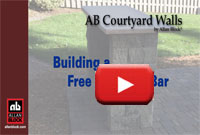
Video: How to a Build Free Standing Bar-VS 2
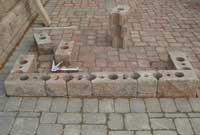
Mark the layout and begin building the first course(s)

Install the foot rest and stack the next two courses
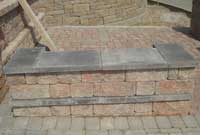
Install the shelf
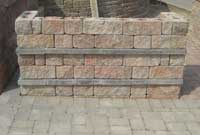
Build the next tweo courses
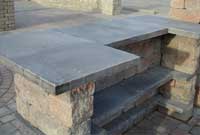
Add the Countertop
Approximate Dimensions:
The dimensions for this bar are 71.5 in. wide and 22.5 in. deep (1.8 m by 0.6 m) and 6 or 7 courses high, depending on the application. This example shows the installation steps for a 7 course high bar with the first course placed on a level gravel base prior to the installation of the patio.
Materials Needed:
Bar 6 Courses High
- 10 AB Dublin
- 18 AB Yorks (2 - split in half)
- 24 AB Corner blocks (4 - cut for end pieces)
- 6 - 12 in. x 24 in. solid surface material (305 mm x 610 mm)
- 2 - 18 in. x 24 in. solid surface material (460 mm x 610 mm)
- 3 - 24 in. x 36 in. solid surface material (610 mm x 915 mm)
- 4 Tubes of masonry adhesive
- 1 - 4ft (1.2m) Aluminum angle w/inserts & screws
Bar 7 Courses High
- 11 AB Dublin
- 21 AB Yorks (3 - split in half)
- 28 AB Corner blocks (6 - cut for end pieces)
- 6 - 12 in. x 24 in. solid surface material (305 mm x 610 mm)
- 2 - 18 in. x 24 in. solid surface material (460 mm x 610 mm)
- 3 - 24 in. x 36 in. solid surface material (610 mm x 915 mm)
- 4 Tubes of masonry adhesive
- 1 - 4ft (1.2m) Aluminum angle w/inserts & screws
Tools Needed:
- Square
- Measuring Tape
- String Line
- Level
- Hammer & Chisel
- Safety Glasses & Work Gloves
Step 1: Mark the Location
Determine the location of the bar. Remember to leave enough space behind the bar to accommodate the bartender or additional seating.
Step 2: Build the First 2 Courses
Using the patterns shown below, in the area selected for your bar, layout the blocks for the first 2 courses. Use the AB Dublin, AB York and Corner blocks to install the first 2 courses. The first course of blocks need to be installed with the blocks facing up (raised rings up). All of the 2nd course blocks need to be installed with all of the blocks facing down (raised rings down). This will create a flat surface for the next step. The AB Dublin blocks are angled and the AB York blocks have a long and short side.
On the 1st course a few additional adjustments will need to be made for the blocks to be spaced properly. An AB York block will need to be split in half and placed at the ends of the panels. Two corner blocks will need to be cut to match up with the second course to a length of 22.5 in (0.6 m). Learn more about cutting and splitting blocks.
Step 3: Install the Foot Rest
With the 2nd course completed, the foot rest can be installed. Using a solid, smooth outdoor material that is available in multiple sizes, install the foot rest as shown here. In our example we are using individual flat concrete slabs. Use a masonry adhesive to secure the foot rest slabs to the course above and below the foot rest. Install the panels with a slight overhang over the blocks face to create the foot rest.
Step 4: Install 3rd & 4th Courses
Using the patterns shown above for the 3rd and 4th course, install the next 2 courses. Remember to use masonry adhesive to secure the 3rd course to the foot rest. This time course 4 will need to be installed upside down to accommodate the shelf installation in Step 5.
Step 5: Install the Shelf
As done in Step 3, using the same material just larger pieces, install a shelf area for the bar. Use masonry adhesive to attach to the course below in Step 3.
Step 6: Install Additional Courses
Using the patterns, install the final 3 courses. Course 5 and 6 can be installed right side up (raised rings up), with course 7 being installed upside down (raised rings down) to create a smooth surface for the counter top to sit on. Remember to secure Course 5 with masonry adhesive to the top of the shelf pieces below.
Step 7: Install Countertop
Using the same type of material used for the shelf and foot rest, install the countertop. Preset the countertop pieces to determine the proper overhang. Adhere one of the end panels in place using masonry adhesive. Place extra blocks on top of the countertop to hold it in place while the adhesive sets up. Continue installing the countertop by placing the center and end panel next. Be sure to use extra blocks and clamps (if needed) to hold the countertop in place while the adhesive sets up.
If using multiple pieces to create your countertop, the center piece may need additional reinforcement due to the weight of the forward overhang. Use a 4 ft (1.2 m) long piece of aluminum angle centered on the underside of the center piece. Use screws and masonry inserts to secure the aluminum angle to the underside of all the countertop pieces. Be sure to keep the center piece fully braced until the aluminum angle is secured into place.
Building a 6 Course High Bar on an Existing Level Surface
To build an AB Courtyard Bar on top of an existing level surface like a patio, you will have to make some changes to the steps previously shown on this how-to sheet. Begin the project as shown in Step 1. In Step 2, eliminate the first course and begin building with course 2. This “new” first course will need to be placed right side up (raised rings up).You will need to remove the raised rings from this course to create a flat surface for the foot rest in Step 3 to rest on. Continue building by following Steps 3-7.